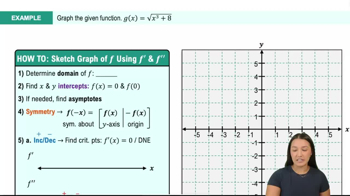Table of contents
- 0. Functions7h 52m
- Introduction to Functions16m
- Piecewise Functions10m
- Properties of Functions9m
- Common Functions1h 8m
- Transformations5m
- Combining Functions27m
- Exponent rules32m
- Exponential Functions28m
- Logarithmic Functions24m
- Properties of Logarithms34m
- Exponential & Logarithmic Equations35m
- Introduction to Trigonometric Functions38m
- Graphs of Trigonometric Functions44m
- Trigonometric Identities47m
- Inverse Trigonometric Functions48m
- 1. Limits and Continuity2h 2m
- 2. Intro to Derivatives1h 33m
- 3. Techniques of Differentiation3h 18m
- 4. Applications of Derivatives2h 38m
- 5. Graphical Applications of Derivatives6h 2m
- 6. Derivatives of Inverse, Exponential, & Logarithmic Functions2h 37m
- 7. Antiderivatives & Indefinite Integrals1h 26m
- 8. Definite Integrals3h 25m
5. Graphical Applications of Derivatives
Curve Sketching
Problem 3.6.59b
Textbook Question
{Use of Tech} Bungee jumper A woman attached to a bungee cord jumps from a bridge that is 30 m above a river. Her height in meters above the river t seconds after the jump is y(t) = 15(1+e^−t cos t), for t ≥ 0.
b. Use a graphing utility to determine when she is moving downward and when she is moving upward during the first 10 s.
 Verified step by step guidance
Verified step by step guidance1
First, identify the function that represents the height of the woman above the river: y(t) = 15(1 + e^{-t} ext{cos}(t)).
Next, find the derivative of the height function y(t) with respect to time t, which will give you the velocity function v(t). This is done using the product rule and chain rule of differentiation.
Set the velocity function v(t) equal to zero to find the critical points, which will indicate when the woman changes direction (from moving upward to downward or vice versa).
Evaluate the sign of the velocity function v(t) in the intervals determined by the critical points to determine when she is moving upward (v(t) > 0) and when she is moving downward (v(t) < 0).
Use a graphing utility to visualize the height function y(t) and the velocity function v(t) over the interval from t = 0 to t = 10 seconds to confirm your findings.
Recommended similar problem, with video answer:
 Verified Solution
Verified SolutionThis video solution was recommended by our tutors as helpful for the problem above
Video duration:
2mPlay a video:
Was this helpful?

 11:41m
11:41mWatch next
Master Summary of Curve Sketching with a bite sized video explanation from Callie
Start learning




